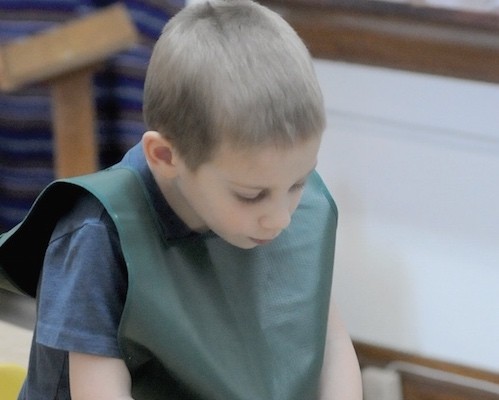Every Wednesday morning, Ann Marschel drives from her home in Rice to St. Mary’s Cathedral in St. Cloud, where her son, William, 4, attends “Catechesis of the Good Shepherd,” a faith formation program for children ages 3 to 6.
When he arrives, William carefully removes his shoes before entering the special classroom called the “atrium,” located in Mary Center behind the cathedral. Then, he heads for one of dozens of miniature “stations” set up around the room.

Some days he likes to mix yeast, flour and water together to make dough, which he then kneads. Other times he mingles water and “wine” in tiny vessels like the ones a priest uses at Mass or strings together beads on a cord.
This Montessori style of hands-on learning is taught by Ellen Palmer, a retired Montessori teacher who has dedicated much of her time and resources in the last five years to collecting materials she uses in the atrium.
“When you believe in something, you support it,” Palmer said. “If you are into cars, you put your time and money into cars. This is what I am into, so this is what I support.”
After retiring, Palmer asked herself what she was going to do. She came across an article that talked about the Catechesis of the Good Shepherd and thought it would be a good fit.
That was five years ago. Palmer approached the person who was St. Mary’s faith formation director at the time, who liked the idea because it was aimed at preschool-age children, an age group that often doesn’t have an organized faith formation program.
The director wrote and received a grant so Palmer could undergo the 90 hours of required training at Pax Christi Church in Rochester, Minnesota, to be certified in teaching the Catechesis of the Good Shepherd.
Creative, effective learning
According to the National Association of the Catechesis of the Good Shepherd, this faith formation program is the result of a long period of careful observation of children by Sofia Cavalletti and her Montessori collaborator, Gianna Gobbi, in Rome.
“We believe that God and the child have a unique relationship with one another particularly before the age of six and that the growth of this relationship should be assisted by the adult, but is directed by the Spirit of God within the child,” according to the association’s website. “Children need their own place to foster the growth of that relationship. We believe that the child’s spiritual growth is best served through tangible but indirect means.”

The class at St. Mary’s meets weekly for about 90 minutes each session. There is a morning session which currently has seven students and an evening session with 14 children.
Marschel, who is a teacher in Royalton, sat in on some of William’s first classes with Palmer and continues to be impressed by the things he learns each week.
With miniature stations for washing hands, a snack station, an “altar” where they can practice setting up for Mass and lots of materials that teach Bible stories, liturgical seasons and traditions, children are allowed to freely move from station to station, spending as much time at each location as they wish. The stations are kept in place throughout the school year so that children can come back to them as often as they like.
At the end of each session, they have prayer time, including silent prayer, talk about what they are thankful for and sing songs.
“William loves to sing. He will sing about Jesus, Mary, about angels. Angels have been really big for him. We also notice that in his prayer time, or in spontaneous prayer with us, he is more willing to participate,” Ann said.
“It’s amazing to see that Jesus is so real to him. To see him and hear him articulate his own perspective of what God means to him right now, at this age, is amazing.”
Lasting impact
Jeff Kaster, director of the Youth in Theology and Ministry Program at St. John’s University School of Theology and Seminary, introduces this model of faith formation to his students each spring.
“I think it is the most creative and effective way to do catechesis with children,” Kaster said. “It uses the creativity and imagination of children to help foster a personal relationship with Jesus Christ. Using the parable of the Good Shepherd, Sofia Cavalletti says the key line children pull from it is, ‘He knows my name; he calls me by name.’”
Kaster said Cavalletti’s argument is that children have a natural innate connection to God and that using “holy play” is a bridge that connects them in a deep way to God, creating an “encounter,” a word Pope Francis uses regularly.
“Pope Francis says that having an encounter with Christ is an essential aspect of Christian discipleship,” Kaster said. “Catechesis of the Good Shepherd is supporting small children in their encounter with Christ.”
But there are a number of challenges to this type of faith formation. It requires a great amount of training and dedication by its instructors as well as a dedicated space in parishes. And many people just aren’t aware of this form of catechesis, Kaster said.
“It really works,” he said. “It works in connection to the aims of what faith formation is supposed to be — to foster Christian discipleship. This works with small children as a foundation for starting their discipleship journey.”
Cavalletti believed that one of the gifts of the program was that the teacher learned just as much or more from the students.
“Amen to that,” Palmer said. “Part of the program is that we don’t always answer the students’ questions. We wonder right along with them. So much in our faith is unanswered questions. This program gives them the opportunity to come to some of the answers on their own.”






















